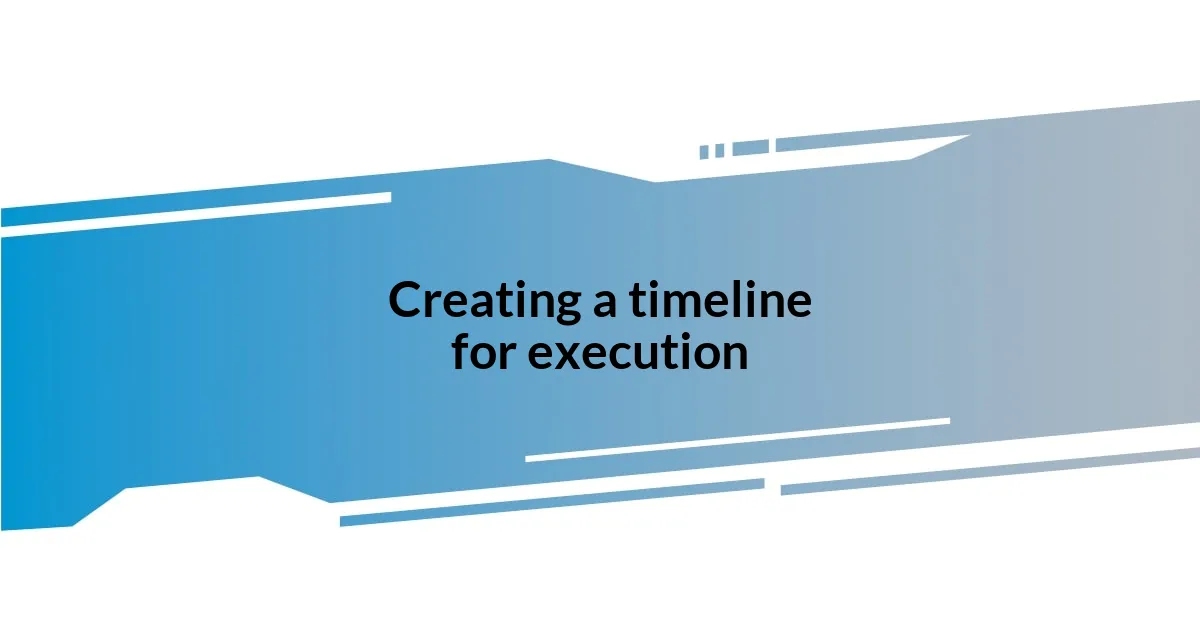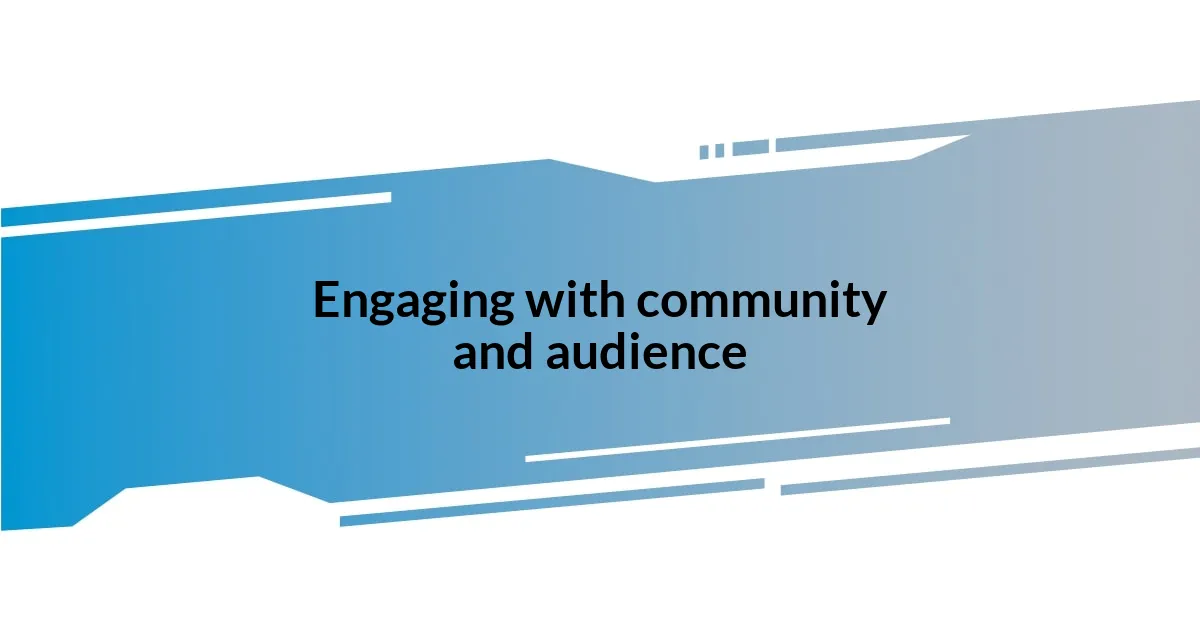Key takeaways:
- Choosing a relatable theme, such as transformation, is crucial for emotional connection with the audience.
- Planning the installation layout involves creating a narrative flow and considering audience interaction to enhance engagement.
- Selecting materials thoughtfully enhances the theme and emotional impact of the installation.
- Engaging with the community and documenting the process fosters connection and enriches the overall artistic experience.

Choosing the installation theme
Choosing the installation theme can feel like an intricate puzzle. In my experience, it was essential to identify a subject that resonated with my own passions and experiences. I often asked myself, “What story do I want to tell?”
One theme that struck me during my deliberations was the concept of transformation. I recalled a powerful moment in my life when I underwent significant personal change. This realization prompted me to envision an installation that represented growth and evolution, making it relatable to others who have faced their own transformations.
As I refined my theme, I found it was crucial to consider the audience’s reaction. Would they connect with my vision? I remember feeling both excited and vulnerable, knowing my chosen theme needed to evoke emotion and provoke thought. This aspect made the process not only creative but deeply personal, allowing me to share a piece of myself through my art.

Planning the installation layout
Planning the installation layout was like mapping out a journey. I wanted each piece to flow into the next, reflecting the narrative I had in mind. I vividly remember sketching my ideas on paper, using color codes to indicate which pieces would resonate together. It wasn’t just about aesthetics; I aimed to create an immersive experience that would lead the viewer from one emotion to another.
In my first installation, space played a crucial role. I learned that the arrangement of artworks influences how an audience perceives them. I placed intimate pieces in cozy corners to invite introspection while showcasing larger, bolder works in more open areas to inspire awe. This contrast made my layout feel dynamic, encouraging viewers to navigate through different feelings.
As I laid out the plan, I constantly visualized the audience’s movements and reactions. I asked myself, “How will people interact with each piece?” This thought was pivotal; it fueled my creativity, pushing me to ensure each section would captivate attention and invite contemplation. I can still recall the excitement I felt as I finalized the layout, knowing that I was crafting a visual journey that would connect deeply with others.
| Aspect | Details |
|---|---|
| Flow | Creating a narrative through pieces to guide audience experience |
| Space | Using intimate locations for introspective art versus open spaces for dramatic pieces |
| Interaction | Anticipating audience movements to enhance engagement with the installation |

Selecting materials and tools
Selecting the right materials and tools for my installation felt like gathering the essential ingredients for a recipe. Each choice had to align with my vision and withstand the emotional weight of the theme I had chosen. I remember wandering through art supply stores, feeling a mix of excitement and anxiety about making the right decisions. Would the textures I select enhance the story of transformation I wanted to share? It was a balancing act—finding materials that were both visually appealing and meaningful.
Here are some key materials and tools that I found particularly helpful during this process:
- Canvas or Wood Panels: I opted for sturdy canvases that could hold the weight of my vision.
- Paints and Brushes: Choosing high-quality acrylics allowed me to create vivid colors, essential for conveying emotions.
- Adhesives and Fasteners: Strong adhesives ensured that elements of my installation stayed in place, adding to the overall impact.
- Lighting: I invested in adjustable lights to highlight certain pieces, creating a specific ambiance that resonated with feelings of growth.
- Textural Elements: I added various fabrics and natural materials to evoke a sense of touch, deepening the viewer’s connection to the theme.
By thoughtfully selecting each material, I felt that my installation would embody the ideas I had swirling in my mind, ultimately inviting viewers to share in my journey of transformation.

Creating a timeline for execution
Creating a timeline for execution was, for me, like constructing the backbone of my installation project. I vividly recall sitting down with my planner, marking key dates on a calendar, and asking myself, “What needs to happen first?” I realized that breaking the entire process into manageable stages not only kept me organized but also turned what initially felt overwhelming into a series of achievable goals.
As I mapped out my timeline, I prioritized tasks by their importance and dependencies. Planning logistics, like securing the venue and coordinating with other artists, had to happen first. I can still remember the rush I felt when I booked the venue—knowing I had a place to bring my vision to life felt like unlocking a door to endless possibilities. It was during these moments that I appreciated the power of a well-structured timeline; it transformed chaos into creativity, allowing me to focus on the artwork itself.
I also built in buffer time, which proved invaluable. Unexpected challenges, like shipping delays or last-minute changes in the layout, can arise. Reflecting on my experience, I learned to embrace these hiccups rather than see them as setbacks. They became opportunities for improvisation, helping me refine my vision as the installation evolved. How often do we get to adapt and grow in real time? It’s a beautiful lesson that unfolded as I adhered to my timeline yet remained flexible to change, and I wouldn’t have traded that experience for anything.

Engaging with community and audience
Engaging with the community and audience was crucial for me during the installation process. I recall the vibrant conversations I had with local artists and art enthusiasts at community events. Each dialogue enriched my understanding of what the installation might mean to others, sparking ideas I had never considered. Have you ever felt that moment of clarity from a simple interaction? It reminded me that art is not created in isolation; it’s a collective experience that thrives on shared perspectives.
Involving the audience meant going beyond the artwork itself. I hosted a small open studio session prior to the installation, inviting friends and strangers alike to share their thoughts and feelings about transformation. Some shared powerful personal stories that resonated with my theme, and I was struck by how our lives could intertwine through art. Watching their eyes light up as they connected with my vision was profoundly fulfilling. It wasn’t merely about displaying my work; it was about creating a dialogue that allowed my audience to feel seen and understood.
Fostering a sense of community doesn’t just enhance the experience; it becomes part of the artwork. I made a conscious effort to encourage feedback and questions throughout my installation. I remember the exhilarating moment when a visitor pointed out a piece that reflected their own journey. In that instant, I saw the potential for a deeper connection that transcended the canvas. Art has this incredible power to bridge gaps and foster understanding, and being part of that exchange was one of the most rewarding aspects of my curation journey. How can we foster these connections more intentionally? It’s a question that continues to inspire my approach to community engagement.

Documenting the installation process
Documenting the installation process became a transformative experience for me. I started by capturing each phase through photographs and notes, allowing me to reflect on the progress in real-time. There’s something magical about looking back at those initial sketches and contrasting them with the finished installation; it’s like watching a beautiful metamorphosis unfold before your eyes.
As I meticulously documented the creative journey, I found myself immersed in a whirlwind of emotions—excitement, uncertainty, and sheer joy. I remember a particularly daunting day when nothing seemed to align. My recorded thoughts, peppered with snippets of my frustration, actually helped ground me. It was through these notes that I was able to pinpoint what worked and what didn’t. Isn’t it interesting how our personal reflections can guide future creations?
In addition to my written observations, I also turned to video. This allowed me to capture the installation from different angles, showcasing not only the physical process but my interactions with the materials. I loved sharing these snippets on social media. Engaging with my audience in this manner created anticipation and excitement, amplifying the communal experience of the installation. Reflecting on this, it struck me how documentation isn’t just about recording; it’s about storytelling, connecting, and inviting others into your creative world. How often do we share our process with others, making them feel part of our journey? It’s a symbiotic relationship that can truly elevate the impact of what we create.